ASTM-D3330剥离强度测试标准中文版
不干胶剥离力测试标准

不干胶剥离力测试标准
1. GB/T2792-1998 光面材料的不干胶剥离力试验
该标准适用于测定不干胶标签材料与基材之间的剥离力。
在测试中,样品要经过一定的处理和贴附程序,以保证测试结果的可靠性。
2. ASTM D3330/D3330M-04 不干胶剥离力试验标准
该标准规定了通过万能试验机进行不干胶剥离力试验的具体步骤和要求。
该标准适用于测定各种形式的不干胶材料与基材之间的剥离力。
3. ISO 8344:1999 Adhesives -- Determination of peel adhesion properties of pressure-sensitive tapes and sheets at 180 degrees angle of peel
该标准针对不干胶材料的90度剥离力进行测试,并规定了所需的剥离速度、试样尺寸等具体要求。
该标准适用于各种形式的不干胶材料与基材之间的剥离力测定。
剥离强度测试标准

剥离强度测试标准剥离强度是指材料在受到外力作用下,与另一材料或基材之间发生分离的抗力。
在工程领域中,剥离强度测试是非常重要的一项指标,它可以帮助我们评估材料的粘接性能和使用寿命,对于各种材料的研发和生产具有重要意义。
因此,建立科学合理的剥离强度测试标准对于保证产品质量和推动材料科学的发展具有重要意义。
首先,剥离强度测试标准需要明确测试方法和设备的选择。
常见的剥离强度测试方法包括剥离试验、剥离剪切试验、剥离拉伸试验等。
不同的测试方法适用于不同类型的材料和应用场景,因此在制定标准时需要根据具体情况进行选择。
同时,测试设备的选择也至关重要,需要确保设备的精度和稳定性,以保证测试结果的准确性和可靠性。
其次,在制定剥离强度测试标准时,需要考虑到材料的特性和使用环境的影响。
不同类型的材料在剥离强度测试时可能会存在不同的表现,例如金属材料、塑料材料、复合材料等。
因此,需要针对不同类型的材料制定相应的测试标准,以确保测试结果的可比性和准确性。
同时,使用环境的影响也需要考虑在内,例如温度、湿度、化学介质等因素都可能对剥离强度产生影响,因此需要在测试标准中进行相应的规定和控制。
另外,剥离强度测试标准还需要考虑到测试过程中可能存在的误差和不确定性。
在实际测试过程中,可能会受到操作技术、设备精度、环境条件等因素的影响,导致测试结果的误差和不确定性。
因此,在制定测试标准时需要考虑到这些因素,并在标准中进行相应的规定和控制,以确保测试结果的可靠性和可重复性。
最后,在制定剥离强度测试标准时,需要考虑到国际标准的参考和对接。
随着全球化的发展,国际标准在各个领域都具有重要的影响力,对于推动行业发展和促进国际交流具有重要意义。
因此,在制定剥离强度测试标准时,需要充分考虑到国际标准的要求和趋势,以便更好地对接国际标准,提高我国在该领域的话语权和影响力。
综上所述,剥离强度测试标准的制定需要考虑到测试方法和设备的选择、材料特性和使用环境的影响、测试过程中的误差和不确定性,以及国际标准的参考和对接。
剥离强度测试标准

剥离强度测试标准剥离强度测试是指在一定条件下,将两个物体之间的粘合强度进行测试的一种方法。
在工程领域中,剥离强度测试被广泛应用于各种材料的粘接性能评估,如胶粘剂、涂料、复合材料等。
剥离强度测试标准的制定对于保证产品质量、推动材料科学研究具有重要意义。
首先,剥离强度测试标准的制定需要考虑测试方法的准确性和可重复性。
测试方法应该能够准确地反映出材料的粘接性能,同时能够在不同实验室和不同操作者之间获得可重复的结果。
为了达到这一目的,国际上已经建立了一系列的剥离强度测试标准,如ASTM D903、ISO 4624等,这些标准详细规定了测试样品的制备、测试条件、数据处理等方面的要求,确保了测试结果的准确性和可比性。
其次,剥离强度测试标准的制定需要考虑不同材料和应用领域的特殊要求。
不同材料的粘接性能受到许多因素的影响,如表面处理、粘接剂的种类和用量、环境温湿度等。
因此,针对不同材料和应用领域,需要制定相应的剥离强度测试标准,以确保测试结果能够准确反映出实际使用条件下的粘接性能。
此外,剥离强度测试标准的制定还需要考虑测试设备和仪器的要求。
测试设备的精度和稳定性直接影响到测试结果的准确性,因此需要制定相应的设备要求和校准方法。
同时,还需要考虑到测试仪器的易用性和安全性,以确保测试操作的可靠性和操作者的安全。
总的来说,剥离强度测试标准的制定是一个复杂而严谨的过程,需要考虑到多个方面的因素。
只有制定了科学合理的标准,才能够保证测试结果的准确性和可比性,推动材料科学研究和工程应用的发展。
因此,我们需要不断完善和更新剥离强度测试标准,以适应不断发展的材料科学和工程技术的需求。
ASTMD3330压敏胶带剥离强度测试标准翻译版

ASTMD3330压敏胶带剥离强度测试标准翻译版一、引言压敏胶带在日常生活和工业生产中都有着广泛的应用,其性能的优劣直接影响到使用效果和产品质量。
而剥离强度作为评估压敏胶带质量的重要指标之一,准确的测试方法至关重要。
ASTMD3330 标准规定了一种常用的压敏胶带剥离强度测试方法,为了让更多相关人员能够理解和应用这一标准,我们对其进行了翻译和解读。
二、测试设备和材料(一)测试设备1、拉力试验机:能够以恒定的速度进行拉伸,并准确测量施加的力和位移。
2、夹头:用于固定胶带和测试板,确保在测试过程中不会出现滑移。
(二)测试材料1、标准测试板:一般采用不锈钢板,表面光滑、平整,尺寸符合标准要求。
2、压敏胶带:待测试的压敏胶带样品。
三、测试样品的制备(一)胶带粘贴将压敏胶带粘贴在标准测试板上,粘贴过程中要避免气泡和褶皱的产生,确保胶带与测试板完全贴合。
(二)静置时间粘贴完成后,将样品在标准环境下静置一定时间,以保证胶带的粘性充分发挥。
四、测试步骤(一)安装样品将带有胶带的测试板安装在拉力试验机的夹头上,确保夹头牢固夹住测试板,胶带的自由端处于垂直向下的位置。
(二)设定测试参数根据标准要求,设定拉力试验机的拉伸速度。
(三)进行测试启动拉力试验机,以设定的速度拉伸胶带,直至胶带从测试板上完全剥离。
在测试过程中,要记录施加的力和位移数据。
五、数据处理和结果表示(一)数据记录记录测试过程中的最大剥离力值。
(二)结果计算根据测试得到的数据,计算平均剥离强度,单位通常为牛顿/厘米(N/cm)或磅/英寸(lb/in)。
(三)结果表示将测试结果以清晰、准确的方式表示出来,包括测试样品的详细信息、测试条件和最终的剥离强度值。
六、测试的注意事项(一)环境条件测试应在标准的环境温度和湿度下进行,以确保测试结果的准确性和可比性。
(二)操作规范操作人员应严格按照测试步骤进行操作,避免因操作不当导致测试结果的偏差。
(三)设备校准定期对拉力试验机进行校准,确保测试设备的准确性和可靠性。
ASTM-D3330剥离强度测试标准中文版
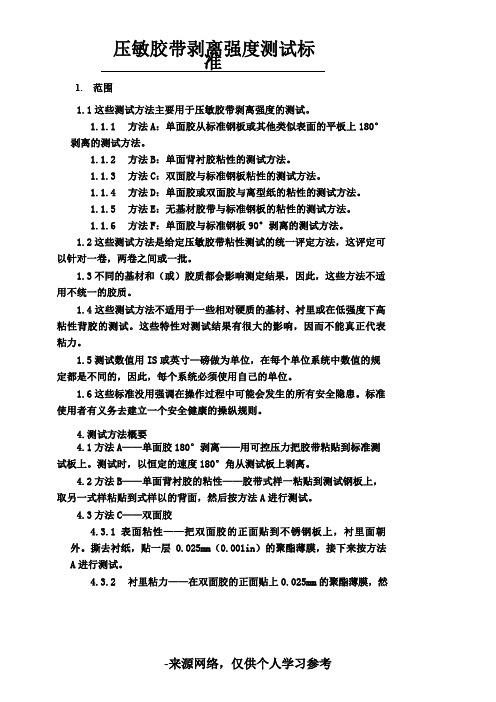
压敏胶带剥离强度测试标准1. 范围1.1这些测试方法主要用于压敏胶带剥离强度的测试。
1.1.1 方法A:单面胶从标准钢板或其他类似表面的平板上180°剥离的测试方法。
1.1.2 方法B:单面背衬胶粘性的测试方法。
1.1.3 方法C:双面胶与标准钢板粘性的测试方法。
4.3.1表面粘性——把双面胶的正面贴到不锈钢板上,衬里面朝外。
撕去衬纸,贴一层0.025mm(0.001in)的聚酯薄膜,接下来按方法A进行测试。
4.3.2 衬里粘力——在双面胶的正面贴上0.025mm的聚酯薄膜,然后撕去衬纸贴到不锈钢板上。
接下来的测试同方法A。
4.4方法D——测试离型纸胶带(单面或者双面)的粘性——把胶带粘贴到测试钢板上,衬里面朝外。
同方法A中单面胶从钢板上剥离类似,用同样的方法测试衬纸与胶粘剂的剥离强度。
4.5方法E——无基材胶带的粘力测试4.5.1正面——把胶带贴到标准测试钢板上。
除去衬纸,贴上厚度为0.025mm的聚酯薄膜形成一个背衬薄膜胶带试样。
按照方法A进行剥离力的测试。
宽度都是可用的。
为了不引起试样边缘破损,取样器也可以选择适合的。
注意1—这些宽度是根据GuideD5750/D5750M的公制计量单位为参照的。
除了欧洲外,所谓的组合公制单位世界通用,如果测试的宽度不同,计算的方法也相应的不同。
注意2—12mm取样刀规格是12mm宽,220mm长的铝制刀柄。
6.2剂量器分配器—溶剂,比如洗涤瓶。
6.3测试板——不锈钢板,50×125,不小于1.1mm厚,表面粗糙高度50±25nm。
测试板如果有锈或者很多刮痕就不能使用。
新板使用前要清洗。
要保护测试板表面不被刮花或污染,其存放条件如10节所述。
6.4压辊——自动或手动6.4.1 压辊钢圈直径85±2.5mm,宽45±1.5mm,表面橡胶6mm左右厚,硬度80±5.压辊表面为无任何凹凸缝隙的光滑圆筒。
ASTM-D3330剥离强度测试标准中文版

压敏胶带剥离强度测试标准1. 范围1.1 这些测试方法主要用于压敏胶带剥离强度的测试。
1.1.1 方法 A:单面胶从标准钢板或其他类似表面的平板上180°剥离的测试方法。
1.1.2 方法B:单面背衬胶粘性的测试方法。
1.1.3 方法C:双面胶与标准钢板粘性的测试方法。
1.1.4 方法D:单面胶或双面胶与离型纸的粘性的测试方法。
1.1.5 方法E:无基材胶带与标准钢板的粘性的测试方法。
1.1.6 方法F:单面胶与标准钢板90°剥离的测试方法。
1.2 这些测试方法是给定压敏胶带粘性测试的统一评定方法,这评定可以针对一卷,两卷之间或一批。
1.3 不同的基材和(或)胶质都会影响测定结果,因此,这些方法不适用不统一的胶质。
1.4 这些测试方法不适用于一些相对硬质的基材、衬里或在低强度下高粘性背胶的测试。
这些特性对测试结果有很大的影响,因而不能真正代表粘力。
1.5 测试数值用 IS 或英寸—磅做为单位,在每个单位系统中数值的规定都是不同的,因此,每个系统必须使用自己的单位。
1.6 这些标准没用强调在操作过程中可能会发生的所有安全隐患。
标准使用者有义务去建立一个安全健康的操纵规则。
4. 测试方法概要4.1 方法 A——单面胶 180°剥离——用可控压力把胶带粘贴到标准测试板上。
测试时,以恒定的速度180°角从测试板上剥离。
4.2 方法 B——单面背衬胶的粘性——胶带式样一粘贴到测试钢板上,取另一式样粘贴到式样以的背面,然后按方法A 进行测试。
4.3 方法C——双面胶4.3.1 表面粘性——把双面胶的正面贴到不锈钢板上,衬里面朝外。
撕去衬纸,贴一层 0.025mm(0.001in)的聚酯薄膜,接下来按方法A 进行测试。
4.3.2 衬里粘力——在双面胶的正面贴上0.025mm 的聚酯薄膜,然后撕去衬纸贴到不锈钢板上。
接下来的测试同方法A。
4.4 方法 D——测试离型纸胶带(单面或者双面)的粘性——把胶带粘贴到测试钢板上,衬里面朝外。
3m胶带测试规范
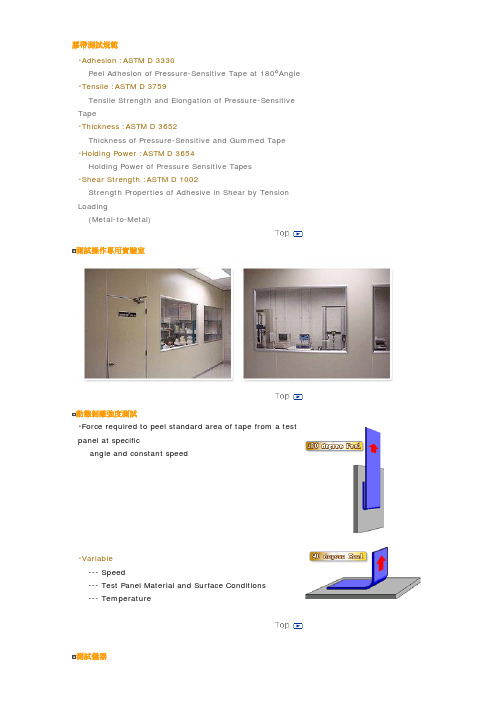
正向拉力
表面能量測試
摩擦力測試
熱壓機
連控老化測試
可程式控制溫濕度烤箱
烤箱
測試儀器
拉力機
離型力測試
厚薄規
靜態剪切強度及保持力 ‧Time Required to shear a defined area of tape from a test panel at constant load ‧Variables --- Load --- Test Panel Material and Surface Conditions --- Temperature
高溫保持力
Dynamic Shear Strength ‧Force Required to shear a standard area of tape from a test panel at constant speed ‧Variable --- Speed --- Test Panel Material and Surface Conditions --- Temperature
ASTM D3330-D3330M

Designation:D3330/D3330M–04Standard Test Method forPeel Adhesion of Pressure-Sensitive Tape1This standard is issued under thefixed designation D3330/D3330M;the number immediately following the designation indicates the year of original adoption or,in the case of revision,the year of last revision.A number in parentheses indicates the year of last reapproval.A superscript epsilon(e)indicates an editorial change since the last revision or reapproval.This standard has been approved for use by agencies of the Department of Defense.1.Scope1.1These test methods cover the measurement of the peel adhesion of pressure-sensitive tapes.1.1.1Test Method A gives a measure of the adherence, when peeled at180°angle,to a standard steel panel or to other surface of interest for a single-coated tape.1.1.2Test Method B gives a measure of the adherence to the backing of a single-coated tape.1.1.3Test Method C gives a measure of the adherence of double-coated tape to a standard steel panel or other surface of interest.1.1.4Test Method D gives a measure of the adherence of the release liner to the adhesive of either single-or double-coated tape.1.1.5Test Method E gives a measure of the adherence of an adhesive transfer tape to a standard steel panel or other surface of interest.1.1.6Test Method F gives a measure of the adherence,when peeled at90°angle,to a standard steel panel or other surface of interest for a single-coated tape.1.2These test methods provide a means of assessing the uniformity of the adhesion of a given type of pressure-sensitive adhesive tape.The assessment may be within a roll of tape, between rolls,or between production lots.1.3Variations in either the tape backing or the adhesive,or both,affect the response.Therefore,these test methods cannot be used to pinpoint the specific cause(s)of non-uniformity.1.4These test methods may not be appropriate to test tapes having relatively stiff backings,stiff liners,or backings show-ing high stretch at low forces.These characteristics will result in a high variability for the test response which is not a true indication of the real nature of the adhesive bond.1.5Values stated in either SI or inch-pound units are to be regarded separately as standard.The values stated in each system may not be exact equivalents,therefore,each system must be used independently without combining values in any way.1.6This standard does not purport to address all of the safety concerns,if any,associated with its use.It is the responsibility of the user of this standard to establish appro-priate safety and health practices and determine the applica-bility of regulatory limitations prior to use.2.Referenced Documents2.1ASTM Standards:2A666Specification for Annealed or Cold-Worked Austen-itic Stainless Steel,Sheet,Strip,Plate,and Flat BarD996Terminology of Packaging and Distribution Environ-mentsD3715/D3715M Practice for Quality Assurance of Pressure-Sensitive TapesD4332Practice for Conditioning Containers,Packages or Packaging Components for TestingD5750Guide for Width and Lengths of Pressure-Sensitive TapeE122Practice for Calculating Sample Size to Estimate, With a Specified Tolerable Error,the Average for Charac-teristic of a Lot or Process2.2AFERA Standard:34001Self adhesive tapes–Measurement of peel adhesion 2.3European Norm:4EN1939Self adhesive tapes–Measurement of peel adhe-sion from stainless steel or from its own backing2.4Pressure Sensitive Tape Council Standards:5PSTC101Peel Adhesion of Pressure Sensitive Tape1These test methods are under the jurisdiction of ASTM Committee D10on Packaging and are the direct responsibility of Subcommittee D10.14on Tape and Labels.Current edition approved Oct.1,2004.Published October2004.Originally approved st previous edition approved in2002as D3330/ D3330M–02e1.2For referenced ASTM standards,visit the ASTM website,,or contact ASTM Customer Service at service@.For Annual Book of ASTM Standards volume information,refer to the standard’s Document Summary page on the ASTM website.3Association des Fabricants Européens de Rubans Auto Adhesifs(AFERA), LAM,Laan Copes van Cattenburch79,NL-2858EW,The Hauge,Netherlands.4European Norm,(EN);available from ComitéEuropéen de Normalisation (CEN),Rue de Stassart,36,B-1050,Brussels,Belgium.5Pressure Sensitive Tape Council(PSTC),400North Michigan Ave.,#2200, Chicago,IL60611–4267.Copyright©ASTM International,100Barr Harbor Drive,PO Box C700,West Conshohocken,PA19428-2959,United States.3.Terminology3.1Definitions—Terminology found in Terminology D996 shall apply.4.Summary of Test Method4.1Test Method A—Single-Coated Tapes,Peel Adhesion at 180°Angle—A strip of tape is applied to a standard test panel (or other surface of interest)with controlled pressure.The tape is peeled from the panel at180°angle at a specified rate,during which time the force required to effect peel is measured.4.2Test Method B—Adhesion to Backing,Single-Coated Tapes—A strip of the tape under test is applied to a rigid panel.A strip of the tape under test is applied to the backing of the first strip of tape and tested for peel adhesion as described in Test Method A.4.3Test Method C—Double-Coated Tapes:4.3.1Face Side Adhesion—The double-coated tape is ad-hered to a stainless steel panel(or other surface of interest), liner side up.The liner is removed and the exposed adhesive covered with a strip of0.025-mm[0.001-in.]thick polyester film.The resulting tape is then tested as described in Test Method A.4.3.2Liner Side Adhesion—The face side adhesive is ad-hered to a0.025-mm[0.001-in.]polyesterfilm.The liner is removed and the tape is applied adhesive down to a stainless steel panel(or other surface of interest).Testing is conducted as described in Test Method A.4.4Test Method D—Adhesion to Liner—The tape is adhered to a standard steel test panel with the liner side up.The liner is peeled from the adhesive in the same manner as in peeling a single-coated tape from a standard panel as described in Test Method A.4.5Test Method E—Adhesion of Adhesive Transfer Tapes: 4.5.1Face Side—The tape is adhered to a standard panel(or other surface of interest).The liner is removed and a0.025-mm [0.001-in.]thick strip of polyester is adhered to form a film-backed strip of tape.The adhesion is measured as de-scribed in Test Method A.4.5.2Linear Side—The transfer tape is applied to a strip of 0.025-mm[0.001-in.]thick polyesterfilm,the liner is removed and the resulting tape’s adhesion is measured as described in Test Method A.4.6Test Method F—Single-Coated Tapes,90°Peel—A strip of tape is applied to a standard test panel(or other surface of interest)with controlled pressure.The tape is peeled from the panel at90°angle at a specified rate,during which time the force required to effect peel is measured.5.Significance and Use5.1These test methods are tools for quality assurance use. Given specific pressure-sensitive tape and a requirement in terms of the minimum or maximum peel value expected for this tape,the data from the test can be used in conjunction with acceptance criteria.5.2Test Method A,B,C,E,or F can show the relative bond strength of a given tape to one or more surfaces(material and texture)as compared to the standard stainless steel panel. Substitution of representative samples of materials in question for the standard steel panel would suffice to do this.5.3Test Methods A,B,C,E or F cannot be used to compare two pressure-sensitive tapes of the same type but of different manufacture for their ability to adhere to a surface.This is because the measured peel force is not normalized for afixed area of stress.The area under stress varies with backing stiffness and adhesive rheology(firmness).Two different tapes seldom agree in these properties.5.4Test Method D can show the amount of force required to remove a liner that covers the adhesive side of a tape at a specified peel rate.The force will be different at other peel rates.5.5These test methods may not provide design information as there is usually no direct relationship between peel adhesion and any functional requirement.6.Apparatus6.1Specimen Cutter—The specimen cutter shall hold two single-edged razor blades in parallel planes,a precise distance apart,to form a cutter of exact specimens widths.Two cutters, 12-and24-mm[0.05-and1-in.]cutting width,shall be available.Appropriate alternates which will not cause edge damage may be used.6N OTE1—The12-mm[0.5-in.]cutter shall consist of a12-mm[0.5-in.] thick by220-mm[8-in.]length aluminum bar stock12-mm[0.05-in.] wide.The edges for about125mm[5in.]from one end shall be slightly rounded to form a handle.The width of the bar for75mm[3in.]from the opposite end shall be narrowed to exactly12mm[0.5in.]minus the thickness of a single razor blade(one of two used as cutting edges).The razor blades shall be held in position using side plates.The end of the cutter shall be cut away at45°angle to expose the cutting edge at one end of the blades.The edges shall be separated by1260.10mm[0.5in.].The 24-mm[1-in.]cutter shall follow the same description except the bar stock shall be24.0mm[1in.]and shall be narrowed exactly24mm[1in.] minus the thickness of a single razor blade.6.2Dispensing System—For solvents,such as a wash bottle.6.3Panel—A stainless steel panel,50by125mm[2by5 in.]no less than1.1mm[0.043in.]thickness,conforming to Type302or304of Specification A666,having a bright annealedfinish.The surface roughness height shall be50625 nm[2.061.0µin.]arithmetical average deviation from the mean line.Panels showing stains,discoloration,or many scratches are not acceptable.New panels should be cleaned prior to use as described in11.1,except with ten washes of the final solvent.Between uses,the panel test surface shall be protected from scratches and contamination,and the panels stored at conditions described in Section10.6.4Roller—Mechanically or hand operated.6.4.1A steel roller8562.5mm[3.2560.1in.]in diameter and4561.5mm[1.7560.05in.]in width,covered with rubber approximately6mm[0.25in.]in thickness,having a Shore scale A durometer hardness of8065.The surface shall be a true cylinder void of any convex or concave deviations. The mass of the roller shall be2040645g[4.560.1lb].6These widths correspond to the primary metric(SI)units described in Guide D5750.These so-called“modular metric”units are used throughout the world, except for Europe.If it is desirable to test slightly different widths(for example,25 mm)of specimens than those described in9.1,this should be noted(see18.1.7)and calculations must also account for the difference(see17.1).6.4.2No part of the apparatus shall increase the mass of the roller during use.The roller shall move either mechanically or by hand at the rate of1060.5mm/s[2460.5in./min].A mechanically operated roller is recommended for referee purposes.N OTE2—A simple check to determine if the rubber surface is cylindri-cal is to wrap the roller in a very thin paper(onionskin)and drag it across aflat glass plate on which is placed carbon paper,face up.The carbon rubs off onto the thin paper wrapper to reveal high spots or hollows on the rubber surface.6.5Adhesion Tester—A constant-rate-of-extension(CRE) tension tester shall be used.It is proposed to use an electronic machine taking at least one reading per mm[0.1in.]of tape peeled.The tester shall have two clamps with centers in the same plane,parallel with the direction of the motion on the stressing clamp,and so aligned that they will hold the specimen wholly in the same plane;a means of moving the stressing clamp at a uniform rate of5.060.2mm/s[1260.5 in./min]and a device for recording load.The instrument shall be calibrated to an accuracy of0.5%of full scale and the scale range used for any test shall be such that the mean test level falls within20to80%of full scale.6.6Fixture—90°peel for Test Method F.7.Reagents and Materials7.1Purity of Reagents—Reagent grade chemicals should be used in all tests.Other grades may be used,provided it isfirst ascertained that the reagent is of sufficiently high purity to permit its use without lessening accuracy of the determination.7.2Solvents:7.2.1Any of the following solvents may be used for cleaning:7.2.1.1Diactone alcohol non-residual,technical grade or better,7.2.1.2Methanol(95%),7.2.1.3Methyl ethyl ketone(MEK),7.2.1.4n-Heptane,or7.2.1.5Acetone.7.2.2For referee testing,thefinal cleaning shall be with MEK or acetone.7.2.3Before selecting or using these solvents for cleaning test panels,be sure to read and follow all precautions on the chemical Material Safety Data Sheets(MSDS)and consult with Environmental,Health,and Safety(EHS)professionals.7.3Cleaning Material—Absorbent,surgical gauze,cotton wool or tissue may be used.To be suitable,materials must be lint-free during use,absorbent,contain no additives that are soluble in the solvents listed in7.2and made exclusively from virgin materials.8.Sampling8.1Acceptance Sampling—Sampling shall be in accordance with Practice D3715/D3715M.8.2Sampling for Other Purposes—The sampling and the number of test specimens depends on the purpose of the testing.Practice E122is recommended.It is common to test at leastfive specimens of a particular tape.Test specimens should be taken from several rolls of tape,and whenever possible, among several production runs of tape.Strong conclusions about a specific property of a tape cannot be based on tests ofa single unit(roll)of a product.9.Test Specimen9.1The specimen shall be24-mm[1-in.]wide.If the specimen is of a different width,refer to Note4.A tolerance of60.5mm[61/64in.]shall be allowed.The length shall be approximately300mm[12in.].9.2Discard at least three but no more than six outer wraps of tape from the sample roll before taking the specimens for testing.9.3Remove one specimen per sample roll for each test to be performed.Remove the specimen from a freely rotating roll at the rate of500to750mm/s[20to30in./s].Where width or other factors causing a high adherence to backing makes it impossible to remove the specimen at the prescribed rate, remove it at a rate as close to500mm/s[20in./s]as possible.9.4When tape is wider than24mm[1in.],specimens of the widest specified width are to be cut from the center of a strip removed from the roll in accordance with9.3.9.5Apply specimen within5min after unwinding.10.Conditioning10.1Condition the sample rolls of tape in the standard conditioning atmosphere as described in Practice D4332for a period of not less than24h.Test at these conditions. (Warning—The tester should know that by prolonged han-dling heat is transmitted to the stainless steel test panel. Therefore,during and after application of the adhesive tape to the test panel,the panel should be handled as little as possible.)11.Test Method A—Single-Coated Tapes at180°Angle 11.1Dispense one of the solvents listed in7.2.1onto the panel,wiping it to dryness with fresh absorbent cleaning material.Repeat for a total of three washes with this solvent. The panel shall be allowed to dry at standard conditions for at least10min.If cleaned panel is not used within10h,it should be recleaned.N OTE3—Discard panels showing stains,discoloration,or many scratches.Avoid contacting panel surface withfingers.During storage, panels should be protected from damage or contamination.11.2Remove a300-mm[12-in.]specimen of the tape to be tested,as described in9.3.Fold12mm[0.5in.]at one end, adhesive to adhesive to form a tab.Touch other end of the specimen to an end of the test panel.Hold the other end of the specimen so that it does not make contact with the panel but is positioned loosely above it.Roll mechanically or by hand twice in each lengthwise direction,causing the roller to apply the tape to the panel.This prevents entrapment of air between the adhesive and the panel.Should this occur,discard the specimen.N OTE4—Where the width of the specimen is less than24mm[1in.], prior to applying test specimen,apply a strip or strips of the tape,to give an equivalent width of24mm[1in.]for rolling purposes or use roller of appropriate weight to obtain a line pressure equal to2040g[4.5lb]for24 mm[1in.]width635%.11.3Individually prepare each specimen and test within1min.N OTE5—Longer dwell time will give different results.Peel adhesion increases with dwell time at different rates for various tapes.A longer dwell time may be chosen purposely.11.4Double back the folded end of the tape at an angle of 180°and peel25mm[1in.]of the tape from the panel.Clamp that end of the panel into the movable jaw of the adhesion testing machine and the free end of the tape into the other jaw. Operate the movable jaw at5.060.2mm/s[1260.5in./min].11.5After the movable jaw is started in motion,disregard the values obtained while thefirst25mm[1in.]of tape is mechanically e the average force obtained during peeling of the next50mm[2in.]as the adhesion value. 12.Test Method B—Adhesion to Backing of Single-Coated Tapes12.1Apply a sample of the tape under test to a rigid panel such as the standard stainless steel panel.Rollfirmly.Apply a second strip of the tape to the backing of the strip on the test panel as described in11.2taking care to align the edges of the second specimen with those of the strip in the test panel. Complete testing as described in11.3-11.5.13.Test Method C—Adhesion of Double-Coated Tape 13.1Face Side—Follow the procedure of11.1-11.3,then remove the liner and superimpose on the test strip a strip of nominal0.025-mm[0.001-in.]thick polyesterfilm,as wide as or slightly wider than the double-coated tape.Apply thisfilm in the manner of applying the double-coated test strip to the panel so that the roller makes the actual application of thefilm to the double-coated tape.N OTE6—The two passes of the roller in applying polyesterfilm may be made using the hand roller.The rolling rate may be increased to50mm/s [2in.]/s.Continue in accordance with11.4and11.5.13.2Liner Side—Adhere the face side of the specimen to a strip of nominal0.025-mm[0.001-in.]thick polyesterfilm in the manner described in11.2so that the roller makes actual application of the tape to thefilm.Trim thefilm to be as wide as or slightly wider than the tape.Remove the liner.Continue in accordance with11.1-11.5.14.Test Method D—Adhesion to Liner of Double-Coatedand Single-Coated Tapes14.1Double-Coated Tapes—Follow11.1.Apply125mm[5 in.]of one end of the specimen to the panel with the adhesive side(face side)down.Make four passes with the roller,twice in each direction at a rate of1060.5mm/s[2460.5in./min]. Separate the liner from the tape at the free end and cut away the free tape.Do not disturb the line adhered to the tape on the panel.Double back the liner and proceed in accordance with 11.4and11.5.14.2Single-Coated Tapes—Follow11.1.Apply a strip of double-coated tape as wide as the specimen,the full length of the panel.Remove the liner from the single-coated tape. Superimpose125mm[5in.]of one end of the specimen, backing side down,against the double-coated tape on the panel.Make four passes with the roller,twice in each direction at a rate of1060.5mm/s[2460.5in./min].Separate the liner from the tape at the free end and cut away the free tape.Do not disturb the liner adhered to the tape on the panel. Double back the liner and proceed in accordance with11.4and 11.5.15.Test Method E—Adhesion of Adhesive TransferTapes15.1Face Side—Follow procedure of11.1-11.3,then re-move the liner and superimpose on the test strip a strip of nominal0.025-mm[0.001-in.]thick polyesterfilm,as wide as or slightly wider than the adhesive transfer tape.Apply this film in the manner of applying described in11.2so that the roller makes the actual application of thefilm to the adhesive transfer tape.Proceed as described in11.4and11.5.15.2Liner Side—Apply to the face side of the adhesive transfer tape a trip of nominal0.025-mm[0.001-in.]thick polyesterfilm.Make two passes of the roller using a hand roller of the same size.The roller rate may be increased to50 mm/s[2in.]/s.Remove the liner from the tape and apply to a standard test panel as described in11.2and11.3.Proceed as described in11.4and11.5.N OTE7—In spite of its apparent simplicity,the use of this test method is rather delicate and involves the use of great care in following the procedure as written to give coherent and identical results between one laboratory and another,as well as between one operator and another. 16.Test Method F—Single Coated Tapes at90°Angle 16.1Prepare specimen for testing as described in11.1-11.3.16.2Double back the folded end of the tape at a90°angle and peel25mm[1in.]of the tape from the panel.Place the panel into afixture clamped to the moving jaw of the adhesion tester so that it will maintain a peeling angle at90°during the peeling of the next75mm[3in.]of tape and the free end of the tape into the other jaw.Operate the moving jaw at5.060.2 mm/s[1260.5in./min].16.3Proceed as described in11.5.17.Calculation17.1In the inch-pound system,if observed pull value is not in Newtons(N),convert to N per10mm by converting the pull value to N and dividing by the width of the tape,mm,and multiplying by10.In the English System,if the observed value is not in ounces,convert to ounces and divide by the specimen width.18.Report18.1Report the following information:18.1.1Statement that these test methods were used and indication of any deviations from the test methods as written, 18.1.2Identification of the source of each roll of tape tested, 18.1.3Description of any anomalous behavior during test-ing(such as adhesive transfer or splitting),18.1.4Peel adhesion value,N/10mm to the nearest0.1 N/10mm[oz/in.to the nearest1oz/in.].Use actual specimen width in calculations,18.1.5Identification of the test method used(A,B,C,D orE)and,if C or E,whether face side or liner side,18.1.6Dwell time,if less or greater than the standard1min, 18.1.7Test specimen widths,if different from9.1,and18.1.8Conditions of test,if other than2361°C[73.46 3.5°C]or5065%RH.19.Precision and Bias19.1Summary—The difference between two single obser-vations should not exceed18.8%of the average of the two observations in95out of100cases when both observations are taken by the same well-trained operator using the same piece of test equipment and the specimens randomly drawn from the same sample of rger differences may occur under all other circumstances.The true value of peel adhesion at180°angle can only be defined in terms of a specified test method. Within this limitation,Test Methods D3330/D3330M has no known bias.The bias for this summary and for evaluations made under other conditions are explained in19.2-19.5.N OTE8—Of the six methods in these test methods only Test Method A was used in determining the precision.It is believed that the precision for the other test methods would be similar.It would probably not apply to Test Method C.19.2Interlaboratory Test Data7—An interlaboratory study was made in1980in which randomly drawn samples of two materials were tested in each of six laboratories.Two operators in each laboratory each tested3specimens from each of3rolls of each material.The components of variance for peel adhesion at180°results expressed as coefficients of variation(see Note 8)and were calculated to be as follows:Specimens of the Same MaterialSpecimens of Different MaterialSingle-operator component 4.8%of the average9.7%of the average Within-Laboratory component 2.1%of the average0%of the average Between-Laboratory component9.0%of the average 3.7%of the average Replication component 4.9%of the average 4.9%of the average19.3Critical Differences—For the components of variance reported in19.2,two averages of observed values should be considered significantly different in the95%probability level if the difference equals or exceeds the critical difference shown in Table1.N OTE9—The tabulated values of the critical differences and confidence limits should be considered to be general statements particularly with respect to between-laboratory precision.Before a meaningful statement can be made about two specific laboratories,the amount of statistical bias between them,if any,must be established with each comparison being based on recent data obtained on specimens randomly drawn from one sample of the material to be evaluated.19.4Confidence Limits—For components of variance re-ported in19.2,single averages of observed values have the following95%confidence limits.See Note9and Table2. 19.5Bias—No justifiable statement can be made on the bias of Test Method D3330/D3330M for testing peel adhesion since the true value cannot be established by accepted referee method.20.Keywords20.1adhesion to backing;adhesion to liner;peel adhesion at 90°angle;peel adhesion at180°angle;pressure sensitive tape7Supporting data have beenfiled at ASTM International Headquarters and may be obtained by requesting Research Report RR:D01–1002.TABLE1Critical Difference,Percent of Grand Average for theConditions Noted A,BNumber ofObservations inEach AverageSingle-OperatorPrecisionWithin-LaboratoryPrecisionBetween-LaboratoryPrecision Specimens of the Same Material:118.819.742.5514.515.629.41013.915.029.1 Specimens of Different Material:130.130.131.8528.028.029.41027.327.329.1A The critical differences were calculated using t=1.960which is based on infinite degrees of freedom.B To convert the values of the critical differences to units of measure,multiply the average of the two specific sets of data being compared by the critical differences expressed as a decimal fraction.TABLE2Width of95%Confidence Limits,Percent of the Grand Average for the Conditions Noted A,BNumber ofObservations inEach AverageSingle-OperatorPrecisionWithin-LaboratoryPrecisionBetween-LaboratoryPrecision Specimens of the Same Material:1613.3613.9630.05610.3611.0620.81069.8610.6620.6 Specimens of Different Material:1621.3621.3622.55619.8619.8620.810619.3619.3620.6A The confidence limits are calculated using t=1.960which is based on infinite degrees of freedom.B To convert the values of the confidence limits to units of measure,multiply the average of the specific set of data which is of interest by the confidence limits expressed as a decimalfraction.ASTM International takes no position respecting the validity of any patent rights asserted in connection with any item mentioned in this ers of this standard are expressly advised that determination of the validity of any such patent rights,and the risk of infringement of such rights,are entirely their own responsibility.This standard is subject to revision at any time by the responsible technical committee and must be reviewed everyfive years and if not revised,either reapproved or withdrawn.Your comments are invited either for revision of this standard or for additional standards and should be addressed to ASTM International Headquarters.Your comments will receive careful consideration at a meeting of the responsible technical committee,which you may attend.If you feel that your comments have not received a fair hearing you should make your views known to the ASTM Committee on Standards,at the address shown below.This standard is copyrighted by ASTM International,100Barr Harbor Drive,PO Box C700,West Conshohocken,PA19428-2959, United States.Individual reprints(single or multiple copies)of this standard may be obtained by contacting ASTM at the above address or at610-832-9585(phone),610-832-9555(fax),or service@(e-mail);or through the ASTM website ().。
astmd3330标准

astmd3330标准ASTM D3330标准是一种用于评估双面胶或其他粘合剂剪切性能的测试方法,具体描述了剪切粘接强度的测量过程和相关测试设备的要求。
该标准适用于广泛的应用领域,如汽车、航空航天、电子、建筑等。
ASTM D3330标准主要包括以下几个部分:1.引言:简要介绍了该标准的目的、适用范围和相关定义。
2.设备:详细描述了进行剪切粘接强度测试所需的设备,包括剪切试验机、夹具、胶带样品等。
3.样品的准备:指导如何准备样品,包括选择胶带材料、切割成适当尺寸和形状等。
4.测试程序:详细描述了如何进行剪切粘接强度测试,包括将样品夹入夹具、施加一定力量进行剪切等。
5.数据分析和报告:指导如何处理测试数据,包括计算平均剪切强度、绘制剪切强度-位移曲线等。
ASTM D3330标准的主要目的是评估粘合剂在剪切载荷下的性能,即胶带或其他粘合剂在外力作用下的抗剪切能力。
通过测量剪切粘接强度,可以评估粘合剂的质量,以及预测在实际使用中的可靠性和耐久性。
ASTM D3330标准的应用范围非常广泛。
在汽车工业中,它可以用于评估汽车内饰和外观部件的粘接性能。
在航空航天领域,它可以用于评估飞机结构中使用的粘接剂的性能。
在电子行业,它可以用于评估电子产品中粘胶电子元件的粘接性能。
在建筑行业,它可以用于评估建筑材料的粘接性能,如建筑玻璃的安装。
ASTM D3330标准具有以下优点:1.简单易行:该标准提供了详细的测试步骤和操作指南,使得测试过程相对简单和易行。
2.准确可靠:该标准要求使用专业的设备进行测试,并且提供了准确的数据分析方法,保证了测试结果的准确性和可靠性。
3.可重复性好:通过严格遵循标准的测试程序和要求,可以获得良好的测试重复性。
总结起来,ASTM D3330标准是一种评估双面胶或其他粘合剂剪切性能的测试方法,适用于各个行业中对粘合剂性能进行评估的领域。
该标准具有简单易行、准确可靠和可重复性好的优点,为粘合剂的质量控制和产品性能评估提供了一种有效的测试方法。
剥离强度国际标准
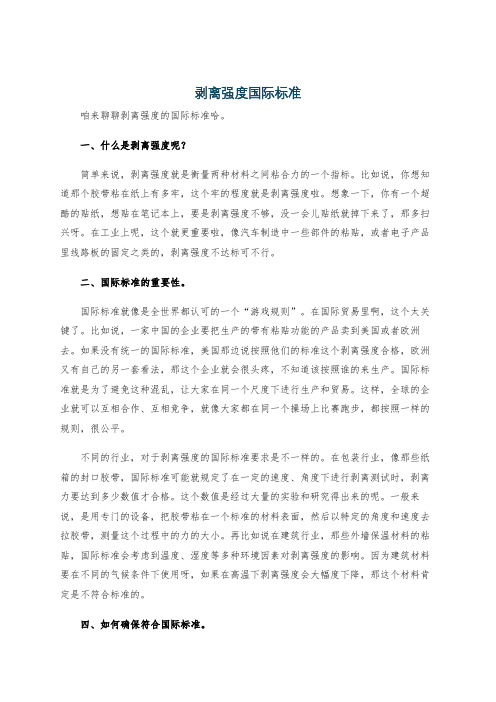
剥离强度国际标准咱来聊聊剥离强度的国际标准哈。
一、什么是剥离强度呢?简单来说,剥离强度就是衡量两种材料之间粘合力的一个指标。
比如说,你想知道那个胶带粘在纸上有多牢,这个牢的程度就是剥离强度啦。
想象一下,你有一个超酷的贴纸,想贴在笔记本上,要是剥离强度不够,没一会儿贴纸就掉下来了,那多扫兴呀。
在工业上呢,这个就更重要啦,像汽车制造中一些部件的粘贴,或者电子产品里线路板的固定之类的,剥离强度不达标可不行。
二、国际标准的重要性。
国际标准就像是全世界都认可的一个“游戏规则”。
在国际贸易里啊,这个太关键了。
比如说,一家中国的企业要把生产的带有粘贴功能的产品卖到美国或者欧洲去。
如果没有统一的国际标准,美国那边说按照他们的标准这个剥离强度合格,欧洲又有自己的另一套看法,那这个企业就会很头疼,不知道该按照谁的来生产。
国际标准就是为了避免这种混乱,让大家在同一个尺度下进行生产和贸易。
这样,全球的企业就可以互相合作、互相竞争,就像大家都在同一个操场上比赛跑步,都按照一样的规则,很公平。
不同的行业,对于剥离强度的国际标准要求是不一样的。
在包装行业,像那些纸箱的封口胶带,国际标准可能就规定了在一定的速度、角度下进行剥离测试时,剥离力要达到多少数值才合格。
这个数值是经过大量的实验和研究得出来的呢。
一般来说,是用专门的设备,把胶带粘在一个标准的材料表面,然后以特定的角度和速度去拉胶带,测量这个过程中的力的大小。
再比如说在建筑行业,那些外墙保温材料的粘贴,国际标准会考虑到温度、湿度等多种环境因素对剥离强度的影响。
因为建筑材料要在不同的气候条件下使用呀,如果在高温下剥离强度会大幅度下降,那这个材料肯定是不符合标准的。
四、如何确保符合国际标准。
五、国际标准的更新。
这个世界在不断地变化,材料也在不断地更新换代,所以剥离强度的国际标准也不是一成不变的。
就像我们的时尚潮流一样,今天流行这个,明天可能就流行那个了。
随着新的材料出现,新的应用场景的产生,国际标准也会不断地进行修订。
pet剥离力测试标准

PET剥离力测试标准通常采用ASTM D3330标准,该标准规定了塑料薄膜和片材的拉伸性能测试方法。
在PET剥离力测试中,试样被固定在两个夹具之间,其中一个夹具可以移动。
在拉伸过程中,试样被逐渐拉离固定夹具,直到试样断裂。
通过测量试样在断裂前所承受的最大拉伸力,可以评估PET材料的剥离强度。
此外,还有一些非标准的方法也可以用来测试PET的剥离力,例如使用专业的剥离力测试仪或手动拉伸试验。
这些方法通常适用于特定的应用场景,如包装、粘合等。
需要注意的是,不同的测试方法和标准可能会产生不同的结果,因此在选择测试方法和标准时,应根据具体的应用场景和需求进行选择。
同时,为了确保测试结果的准确性和可靠性,应遵循相关的测试标准和操作规范,并进行适当的样品准备和数据处理。
ASTMD0剥离强度测试标准中文版(杂项)

压敏胶带剥离强度测试标准. 范围这些测试方法主要用于压敏胶带剥离强度的测试。
方法:单面胶从标准钢板或其他类似表面的平板上°剥离的测试方法。
方法:单面背衬胶粘性的测试方法。
方法:双面胶与标准钢板粘性的测试方法。
方法:单面胶或双面胶与离型纸的粘性的测试方法。
方法:无基材胶带与标准钢板的粘性的测试方法。
方法:单面胶与标准钢板°剥离的测试方法。
这些测试方法是给定压敏胶带粘性测试的统一评定方法,这评定可以针对一卷,两卷之间或一批。
不同的基材和(或)胶质都会影响测定结果,因此,这些方法不适用不统一的胶质。
这些测试方法不适用于一些相对硬质的基材、衬里或在低强度下高粘性背胶的测试。
这些特性对测试结果有很大的影响,因而不能真正代表粘力。
测试数值用或英寸—磅做为单位,在每个单位系统中数值的规定都是不同的,因此,每个系统必须使用自己的单位。
这些标准没用强调在操作过程中可能会发生的所有安全隐患。
标准使用者有义务去建立一个安全健康的操纵规则。
.测试方法概要方法——单面胶°剥离——用可控压力把胶带粘贴到标准测试板上。
测试时,以恒定的速度°角从测试板上剥离。
方法——单面背衬胶的粘性——胶带式样一粘贴到测试钢板上,取另一式样粘贴到式样以的背面,然后按方法进行测试。
方法——双面胶表面粘性——把双面胶的正面贴到不锈钢板上,衬里面朝外。
撕去衬纸,贴一层()的聚酯薄膜,接下来按方法进行测试。
衬里粘力——在双面胶的正面贴上的聚酯薄膜,然后撕去衬纸贴到不锈钢板上。
接下来的测试同方法。
方法——测试离型纸胶带(单面或者双面)的粘性——把胶带粘贴到测试钢板上,衬里面朝外。
同方法中单面胶从钢板上剥离类似,用同样的方法测试衬纸与胶粘剂的剥离强度。
方法——无基材胶带的粘力测试正面——把胶带贴到标准测试钢板上。
除去衬纸,贴上厚度为的聚酯薄膜形成一个背衬薄膜胶带试样。
按照方法进行剥离力的测试。
衬里面——把胶带正面贴上厚度为的聚酯薄膜,撕去衬纸贴后贴到钢板上按方法进行测试。
双面胶带的国标标准
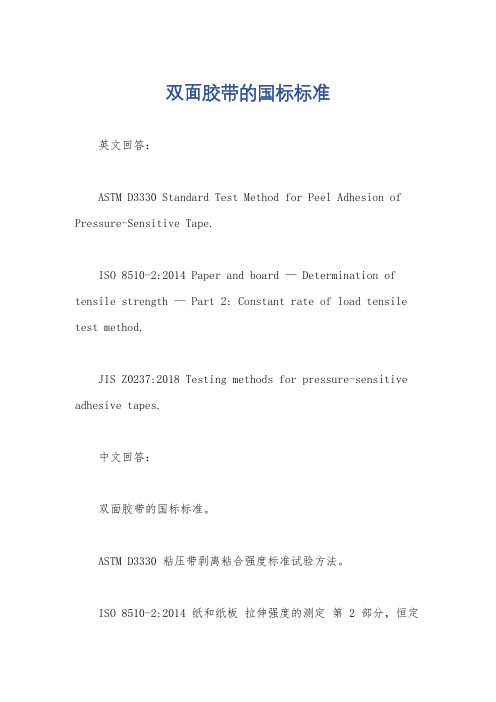
双面胶带的国标标准英文回答:ASTM D3330 Standard Test Method for Peel Adhesion of Pressure-Sensitive Tape.ISO 8510-2:2014 Paper and board — Determination of tensile strength — Part 2: Constant rate of load tensile test method.JIS Z0237:2018 Testing methods for pressure-sensitive adhesive tapes.中文回答:双面胶带的国标标准。
ASTM D3330 粘压带剥离粘合强度标准试验方法。
ISO 8510-2:2014 纸和纸板拉伸强度的测定第 2 部分,恒定载荷拉伸试验方法。
JIS Z0237:2018 压敏胶带测试方法。
ASTM D3330 Standard Test Method for Peel Adhesion of Pressure-Sensitive Tape.Scope.This test method covers the determination of the peel adhesion of pressure-sensitive tape to a standard stainless steel panel. The test is intended to measure the force required to remove the tape from the panel at an angle of 180°.Significance and Use.The peel adhesion strength of pressure-sensitive tape is an important property that indicates its ability to adhere to a surface under conditions of tension. This test method is widely used to characterize the performance of pressure-sensitive tapes and to compare the performance ofdifferent tapes.Procedure.1. Prepare a 1-inch wide test specimen by cutting a strip of tape from the roll.2. Apply the tape to a standard stainless steel panel, ensuring that the tape is applied evenly and without wrinkles.3. Allow the tape to dwell on the panel for a specified period of time (typically 24 hours).4. Peel the tape from the panel at an angle of 180° ata constant rate of 12 inches per minute.5. Record the force required to remove the tape.Report.The report shall include the following information:The type of tape tested.The test conditions.The peel adhesion strength in pounds per inch (N/m)。
剥离强度测试标准

剥离强度测试标准剥离强度测试是一种常见的材料力学性能测试方法,用于评估材料的粘附性能和耐久性。
在工程实践中,剥离强度测试广泛应用于粘接材料、涂层材料、复合材料等领域。
为了保证测试结果的准确性和可比性,制定了一系列的剥离强度测试标准。
本文将介绍几种常见的剥离强度测试标准,以及测试过程中需要注意的关键点。
首先,剥离强度测试标准应符合国际性标准,例如ASTM、ISO 等组织发布的标准。
这些标准通常包括测试样品的准备、试验装置的设计、试验条件的设定、数据处理的方法等内容。
在进行剥离强度测试时,应当严格遵守相关的标准要求,以确保测试结果的可靠性和可比性。
其次,常见的剥离强度测试方法包括剪切剥离试验、拉拔剥离试验、剥离剥离试验等。
每种试验方法都有其适用的材料类型和试验条件。
在选择剥离强度测试方法时,应根据具体的材料特性和测试要求进行合理的选择,并严格按照相关标准进行试验。
另外,剥离强度测试过程中需要注意的关键点包括试验样品的准备、试验装置的校准、试验条件的控制、数据的采集和处理等。
试验样品的准备应符合标准要求,避免样品表面的缺陷和污染对试验结果的影响。
试验装置的校准应定期进行,以确保试验装置的准确性和稳定性。
试验条件的控制应严格按照标准要求进行,包括温湿度条件、加载速率、加载方式等。
数据的采集和处理应使用合适的仪器设备和数据处理方法,以获得准确可靠的试验结果。
在进行剥离强度测试时,还需要注意试验过程中可能出现的问题和异常情况,及时进行处理和记录。
例如试验样品的失效形式、试验装置的故障、数据采集的异常等。
这些问题和异常情况可能对试验结果产生影响,需要及时处理和记录,以保证试验结果的准确性和可靠性。
总之,剥离强度测试标准对于保证试验结果的准确性和可比性具有重要意义。
在进行剥离强度测试时,应严格遵守相关的标准要求,选择合适的试验方法,注意试验过程中的关键点和可能出现的问题,以获得准确可靠的试验结果。
希望本文介绍的内容能够对剥离强度测试工作有所帮助,谢谢阅读!。
ASTM-D3330剥离强度测试标准中文版
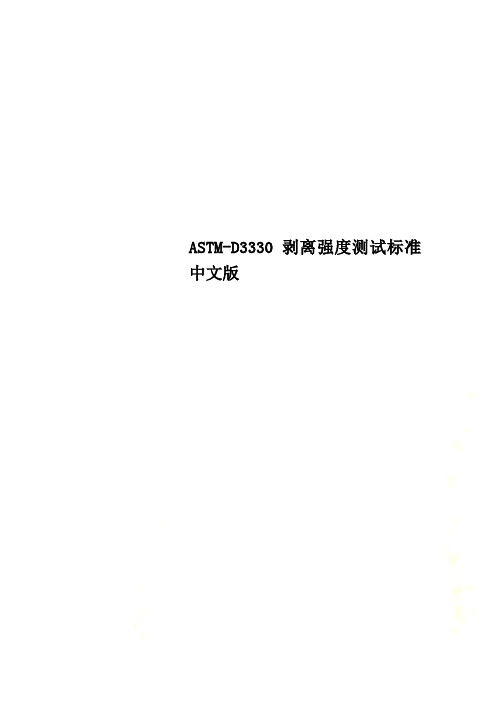
ASTM-D3330剥离强度测试标准中文版压敏胶带剥离强度测试标准1. 范围1.1 这些测试方法主要用于压敏胶带剥离强度的测试。
1.1.1 方法 A:单面胶从标准钢板或其他类似表面的平板上180°剥离的测试方法。
1.1.2 方法B:单面背衬胶粘性的测试方法。
1.1.3 方法C:双面胶与标准钢板粘性的测试方法。
1.1.4 方法D:单面胶或双面胶与离型纸的粘性的测试方法。
1.1.5 方法E:无基材胶带与标准钢板的粘性的测试方法。
1.1.6 方法F:单面胶与标准钢板90°剥离的测试方法。
1.2 这些测试方法是给定压敏胶带粘性测试的统一评定方法,这评定可以针对一卷,两卷之间或一批。
1.3 不同的基材和(或)胶质都会影响测定结果,因此,这些方法不适用不统一的胶质。
1.4 这些测试方法不适用于一些相对硬质的基材、衬里或在低强度下高粘性背胶的测试。
这些特性对测试结果有很大的影响,因而不能真正代表粘力。
1.5 测试数值用 IS 或英寸—磅做为单位,在每个单位系统中数值的规定都是不同的,因此,每个系统必须使用自己的单位。
1.6 这些标准没用强调在操作过程中可能会发生的所有安全隐患。
标准使用者有义务去建立一个安全健康的操纵规则。
4. 测试方法概要4.1 方法 A——单面胶 180°剥离——用可控压力把胶带粘贴到标准测试板上。
测试时,以恒定的速度180°角从测试板上剥离。
4.2 方法 B——单面背衬胶的粘性——胶带式样一粘贴到测试钢板上,取另一式样粘贴到式样以的背面,然后按方法A进行测试。
4.3 方法C——双面胶4.3.1 表面粘性——把双面胶的正面贴到不锈钢板上,衬里面朝外。
撕去衬纸,贴一层 0.025mm(0.001in)的聚酯薄膜,接下来按方法A进行测试。
4.3.2 衬里粘力——在双面胶的正面贴上0.025mm 的聚酯薄膜,然后撕去衬纸贴到不锈钢板上。
接下来的测试同方法A。
ASTM_D3330中英文对照版

ASTM_D3330中英文对照版ASTM D3330中英文对照版Designation:D3330/D3330M–00名称:D3330/D3330M-00Standard Test Method for Peel Adhesion of Pressure-Sensitive Tape1压敏胶带剥离强度测试标准This standard is issued under the fixed designation D3330/D3330M;the number immediately following the designation indicates the year of original adoption or,in the case of revision,the year of last revision.A number in parentheses indicates the year of last reapproval.A superscript epsilon(e)indicates an editorial change since the last revision or reapproval.此标准是根据D3330/D3330M整理修订;名称后面的数字代表首发年份。
括号内为最近修订年份。
带有上标e表示最后一次发行或修订时的改动之处。
1.1.Scope1.1范围1.1.1These test methods cover the measurement of the peel adhesion of pressure-sensitive tapes.1.1.1这些测试方法主要是针对压敏胶带剥离强度的测试1.1.1.1Test Method A gives a measure of the adherence,when peeled at180°angle,to a standard steel panel or to other surface of interest for a single-coated tape.(加载板)1.1.1.1方法A是压敏胶带从一标准金属板180°剥离测试方法;------------2.1.1.2Test Method B gives a measure of the adherence to the backing of a single-coated tape.2.1.1.2方法B是测试单面背衬胶的粘性3.1.1.3Test Method C gives a measure of the adherence of double-coated tape to a standard steel panel or other surface of interest.3.1.1.3方法C是双面背衬胶与标准金属板的粘性测试方法;4.1.1.4Test Method D gives a measure of the adherence of the release liner to the adhesive of either single-or double-coated tape.4.1.1.4方法D是测试单面或者双面背衬胶离型纸的粘性5.1.1.5Test Method E gives a measure of the adherence of an adhesive transfer tape to a standard steel panel or other surface of interest.5.1.1.5方法E是测试无基材胶带与标准金属板之间的粘性6.1.1.6Test Method F gives a measure of the adherence,when peeled at90°angle,to a standard steel panel or other surface of interest for a single-coated tape.6.1.1.6方法F是测试胶带90°剥离方法;7.1.2These test methods provide a means of assessing the uniformity of the adhesion of a given type of pressure-sensitive adhesive tape.The assessment may be within a roll of tape,between rolls,or between production lots.7.1.2这些测试方法,是胶带的统一的评定方法;----------8.1.3Variations in either the tape backing or the adhesive,or both,affect the response.Therefore,these test methods cannot be used to pinpoint the specific cause(s)of non-uniformity.9.1.4These test methods may not be appropriate to test tapes having relatively stiff backings,stiff liners,or backings showing high stretch at low forces.These characteristics will result in a high variability for the test response which is not a true indication of the real nature of the adhesive bond.10.1.5Values stated in either SI or inch-pound units are to be regarded separately as standard.The values stated in each system may not be exact equivalents,therefore,each system must be used independently without combining values in any way.11.1.6These test methods are intended to replace AFERA4001,EN1939,PSTC-1,PSTC-2,PSTC-3and PSTC-4.1.7This standard does not purport to address all of the1These test methods are under the jurisdiction of ASTM Committee D-10on Packaging and are the direct responsibility of Subcommittee D10.14on Tape and Labels.Current edition approved Oct.10, 2000.Published December2000.Originally published as D3330–/doc/7f650282.html,st previous edition D3330/D3330M–99.Copyright. ASTM,100Barr Harbor Drive,West Conshohocken,PA19428-2959,United States.safety concerns,if any,associated with its use.It is the responsibility of the user of this standard to establish appropriate safety and health practices and determine the applicability of regulatory limitations prior to use.2.Referenced Documents2.1ASTM Standards:A666Specification for Austenitic Stainless Steel,Sheet,Strip,Plate and Flat Bar2D996Terminology of Packaging and Distribution Environments3D3715/D3715M Practice for Quality Assurance of Pressure-Sensitive Tapes3D 4332Practice for Conditioning Containers,Packages or Packaging Components for T esting3D5750Guide for Width and Lengths of Pressure-Sensitive Tape3E122Practice for Choice of Sample Size to Estimate a Measure of Quality for a Lot or Process42.2AFERA Standard:54001Self adhesive tapes–Measurementof peel adhesion2.3European Norm:6EN1939Self adhesive tapes–Measurement of peel adhesion from stainless steel or from its own backing 2.4Pressure Sensitive Tape Council Standards:7PSTC-1Peel Adhesion of Single Coated Pressure-Sensitive Tapes at180°Angle PSTC-2Peel Adhesion for Single Coated Pressure-Sensitive Tapes at90°Angle PSTC-3Peel Adhesion of DoubleCoated Pressure-Sensitive Tapes at180°Angle PSTC-4Adhesion to Liner of Presure-Sensitive Tapes at180°Angle1.3.Terminology2.3.1Definitions—T erminology found in Terminology D996shall apply.2Annual Book of ASTM Standards,Vol01.03.3Annual Book of ASTM Standards,Vol15.09.4Annual Book of ASTM Standards,Vol14.02.5Association des Fabricants Européens deRubans Auto Adhesifs(AFERA),LAM,Laan Copes van Cattenburch79,NL-2858EW,The Hauge,Netherlands.6European Norm,(EN);available from ComitéEuropéen de Normalisation(CEN),Rue deStassart,36,B-1050,Brussels,Belgium.7Pressure Sensitive Tape Council(PSTC),400North Michigan Ave.,#2200,Chicago,IL60611–4267.1.4.Summary of Test Method测试方法概要2.4.1Test Method A—Single-Coated Tapes,Peel Adhesion at180°Angle—A strip of tape is applied to a standard test panel(or other surface of interest)with controlled pressure.The tape is peeled from t he panel at180°angle at a specified rate,during which time the force required to effect peel ismeasured.方法A是压敏胶带的180°剥离。
ASTMD3330剥离强度测试标准中文版
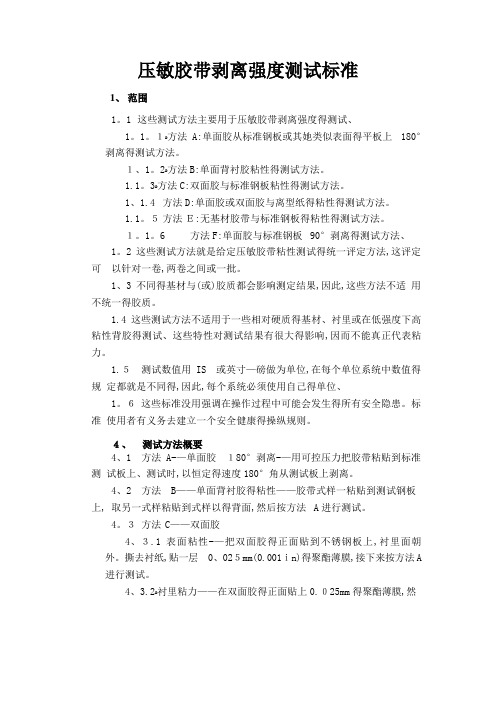
压敏胶带剥离强度测试标准1、范围1。
1 这些测试方法主要用于压敏胶带剥离强度得测试、1。
1。
1ﻩ方法 A:单面胶从标准钢板或其她类似表面得平板上180°剥离得测试方法。
1、1。
2ﻩ方法B:单面背衬胶粘性得测试方法。
1.1。
3ﻩ方法C:双面胶与标准钢板粘性得测试方法。
1、1.4 方法D:单面胶或双面胶与离型纸得粘性得测试方法。
1.1。
5方法E:无基材胶带与标准钢板得粘性得测试方法。
1。
1。
6 方法F:单面胶与标准钢板90°剥离得测试方法、1。
2 这些测试方法就是给定压敏胶带粘性测试得统一评定方法,这评定可以针对一卷,两卷之间或一批。
1、3 不同得基材与(或)胶质都会影响测定结果,因此,这些方法不适用不统一得胶质。
1.4 这些测试方法不适用于一些相对硬质得基材、衬里或在低强度下高粘性背胶得测试、这些特性对测试结果有很大得影响,因而不能真正代表粘力。
1.5测试数值用 IS 或英寸—磅做为单位,在每个单位系统中数值得规定都就是不同得,因此,每个系统必须使用自己得单位、1。
6这些标准没用强调在操作过程中可能会发生得所有安全隐患。
标准使用者有义务去建立一个安全健康得操纵规则。
4、测试方法概要4、1 方法 A-—单面胶180°剥离-—用可控压力把胶带粘贴到标准测试板上、测试时,以恒定得速度180°角从测试板上剥离。
4、2 方法B——单面背衬胶得粘性——胶带式样一粘贴到测试钢板上, 取另一式样粘贴到式样以得背面,然后按方法 A 进行测试。
4。
3方法C——双面胶4、3.1 表面粘性-—把双面胶得正面贴到不锈钢板上,衬里面朝外。
撕去衬纸,贴一层0、025mm(0.001in)得聚酯薄膜,接下来按方法A 进行测试。
4、3.2ﻩ衬里粘力——在双面胶得正面贴上0.025mm 得聚酯薄膜,然后撕去衬纸贴到不锈钢板上。
接下来得测试同方法A。
4.4 方法 D-—测试离型纸胶带(单面或者双面)得粘性——把胶带粘贴到测试钢板上,衬里面朝外。
剥离力美标测试方法
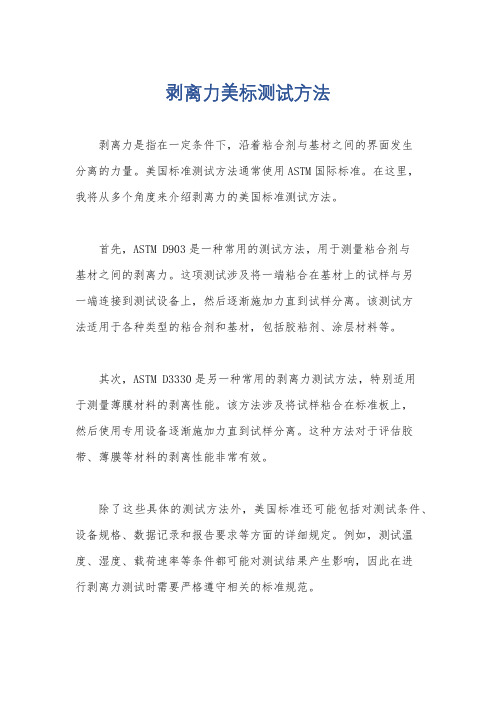
剥离力美标测试方法
剥离力是指在一定条件下,沿着粘合剂与基材之间的界面发生
分离的力量。
美国标准测试方法通常使用ASTM国际标准。
在这里,
我将从多个角度来介绍剥离力的美国标准测试方法。
首先,ASTM D903是一种常用的测试方法,用于测量粘合剂与
基材之间的剥离力。
这项测试涉及将一端粘合在基材上的试样与另
一端连接到测试设备上,然后逐渐施加力直到试样分离。
该测试方
法适用于各种类型的粘合剂和基材,包括胶粘剂、涂层材料等。
其次,ASTM D3330是另一种常用的剥离力测试方法,特别适用
于测量薄膜材料的剥离性能。
该方法涉及将试样粘合在标准板上,
然后使用专用设备逐渐施加力直到试样分离。
这种方法对于评估胶带、薄膜等材料的剥离性能非常有效。
除了这些具体的测试方法外,美国标准还可能包括对测试条件、设备规格、数据记录和报告要求等方面的详细规定。
例如,测试温度、湿度、载荷速率等条件都可能对测试结果产生影响,因此在进
行剥离力测试时需要严格遵守相关的标准规范。
此外,美国标准还可能涉及对测试设备的校准和验证要求,以确保测试结果的准确性和可靠性。
在进行剥离力测试时,操作人员需要严格按照标准规定的程序进行操作,并对测试设备进行定期维护和校准,以确保测试结果的准确性。
综上所述,剥离力的美国标准测试方法涵盖了多个方面,包括具体的测试方法、测试条件、设备要求、数据处理等内容。
在进行剥离力测试时,需要严格遵守相关的标准规范,以确保测试结果的准确性和可靠性。
- 1、下载文档前请自行甄别文档内容的完整性,平台不提供额外的编辑、内容补充、找答案等附加服务。
- 2、"仅部分预览"的文档,不可在线预览部分如存在完整性等问题,可反馈申请退款(可完整预览的文档不适用该条件!)。
- 3、如文档侵犯您的权益,请联系客服反馈,我们会尽快为您处理(人工客服工作时间:9:00-18:30)。
压敏胶带剥离强度测试标准1. 围1.1 这些测试方法主要用于压敏胶带剥离强度的测试。
1.1.1 方法 A:单面胶从标准钢板或其他类似表面的平板上180°剥离的测试方法。
1.1.2 方法B:单面背衬胶粘性的测试方法。
1.1.3 方法C:双面胶与标准钢板粘性的测试方法。
1.1.4 方法D:单面胶或双面胶与离型纸的粘性的测试方法。
1.1.5 方法E:无基材胶带与标准钢板的粘性的测试方法。
1.1.6 方法F:单面胶与标准钢板90°剥离的测试方法。
1.2 这些测试方法是给定压敏胶带粘性测试的统一评定方法,这评定可以针对一卷,两卷之间或一批。
1.3 不同的基材和(或)胶质都会影响测定结果,因此,这些方法不适用不统一的胶质。
1.4 这些测试方法不适用于一些相对硬质的基材、衬里或在低强度下高粘性背胶的测试。
这些特性对测试结果有很大的影响,因而不能真正代表粘力。
1.5 测试数值用 IS 或英寸—磅做为单位,在每个单位系统中数值的规定都是不同的,因此,每个系统必须使用自己的单位。
1.6 这些标准没用强调在操作过程中可能会发生的所有安全隐患。
标准使用者有义务去建立一个安全健康的操纵规则。
4. 测试方法概要4.1 方法 A——单面胶 180°剥离——用可控压力把胶带粘贴到标准测试板上。
测试时,以恒定的速度180°角从测试板上剥离。
4.2 方法 B——单面背衬胶的粘性——胶带式样一粘贴到测试钢板上,取另一式样粘贴到式样以的背面,然后按方法A 进行测试。
4.3 方法C——双面胶4.3.1 表面粘性——把双面胶的正面贴到不锈钢板上,衬里面朝外。
撕去衬纸,贴一层 0.025mm(0.001in)的聚酯薄膜,接下来按方法A 进行测试。
4.3.2 衬里粘力——在双面胶的正面贴上0.025mm 的聚酯薄膜,然后撕去衬纸贴到不锈钢板上。
接下来的测试同方法A。
4.4 方法 D——测试离型纸胶带(单面或者双面)的粘性——把胶带粘贴到测试钢板上,衬里面朝外。
同方法A 中单面胶从钢板上剥离类似,用同样的方法测试衬纸与胶粘剂的剥离强度。
4.5 方法E——无基材胶带的粘力测试4.5.1 正面——把胶带贴到标准测试钢板上。
除去衬纸,贴上厚度为0.025mm的聚酯薄膜形成一个背衬薄膜胶带试样。
按照方法A 进行剥离力的测试。
4.5.2 衬里面——把胶带正面贴上厚度为0.025mm的聚酯薄膜,撕去衬纸贴后贴到钢板上按方法A进行测试。
4.6 方法F——单面胶90°剥离——在可控的压力下把胶贴到标准钢板上,以恒定的速度从钢板上90°角进行剥离测试,计算剥离过程的力。
5. 意义和应用5.1 这些测试方法是为保证质量使用的。
给定的压敏胶在特定条件下测定其最大和最小剥离力,其数值用作验收标准。
5.2 方法A、B、C、E、F还可以用来测定给定胶带与其他一种或多种不同材料和材质的表面的相对粘力。
有代表性的材料式样足以作为标准钢板试验使用。
5.3 方法A, B, C, E or F 不能被用来对比测试同类但不同粘着力的胶带。
这是因为测试的剥离力并没有规为一定压力围。
压力会因为单面背衬的硬度和黏着力度而有所不同。
两种不同胶带极少有相同此类属性。
5.4 方法D 可以测试在特定剥离速度下剥离掉黏胶带的离型纸所需要的不同力值。
不同的剥离速度剥离力值不同。
5.5 这几种测试方法没有提供设计信息,原因在于通常粘着力和功能要求之间没有直接关联。
6. 设备6.1 取样器—取样器应使用两边平行的单刃刀片,精确的分开距离,这样可以剪切出宽度精确的试样。
两种剪切12 和24-mm[0.05-and 1-in.]剪切宽度都是可用的。
为了不引起试样边缘破损,取样器也可以选择适合的。
注意1—这些宽度是根据Guide D 5750/D5750M 的公制计量单位为参照的。
除了欧洲外,所谓的组合公制单位世界通用,如果测试的宽度不同,计算的方法也相应的不同。
注意2—12mm取样刀规格是12mm宽,220mm长的铝制刀柄。
6.2 剂量器分配器—溶剂,比如洗涤瓶。
6.3 测试板——不锈钢板,50×125,不小于1.1mm厚,表面粗糙高度50±25nm。
测试板如果有锈或者很多刮痕就不能使用。
新板使用前要清洗。
要保护测试板表面不被刮花或污染,其存放条件如10节所述。
6.4 压辊——自动或手动6.4.1 压辊钢圈直径85±2.5mm,宽45±1.5mm,表面橡胶6mm左右厚,硬度80±5.压辊表面为无任何凹凸缝隙的光滑圆筒。
滚轴克重为2040±45g。
6.4.2 在使用过程中不能让别的部件增加其重量。
压辊可以是自动的或者以10±0.5mm/s手动操纵,推荐使用自动压辊。
注意 3 有一种检测压辊表面橡胶性能的简易方法。
用薄纸包住橡胶层,然后在铺着复写纸(印面向上)的平板玻璃上滑动。
复印纸的颜色就会被拓到薄纸上,这样就能直观的显现出橡胶表面是否有小的凸起或凹洞。
6.5 粘力检测仪——可能会用到恒速拉力机。
在此推荐使用电子设备能检测每秒的剥离力值。
拉力机的工作台中央有两个动力方向平行的夹具,其同试样统一在同一工作台。
用5.0± 0.2 mm/s恒定速率拉动夹具然后另一装置测试数据。
装置的精确度应达到0.5%,测试水平在满量程的20%到80%之间。
6.6 固定装置——用于方法F的90°剥离。
7. 试剂和材料7.1 试剂的纯度——所有试验用的试剂应该达到化学纯。
如果用其他的纯度的试剂,应该要保证其纯度不影响测试结果才能使用。
7.2 试剂7.2.1 以下是所有可能用作清洗剂的试剂:7.2.1.1 无酒精双丙酮,技术级或者更高,7.2.1.2 甲醇(95%),7.2.1.3 丁酮,7.2.1.4 n—正庚烷,7.2.1.5 丙酮7.2.2 在测试时,最后的清洗应该用到丁酮或丙酮。
7.2.3 在选择和使用试剂清洗钢板之前要谨慎注意化学试剂对环境,身体和安全的影响。
7.3 清洗材料——吸收剂,外科纱布,棉毛或者薄纸。
材料必须为无棉绒纸;吸收剂不能含同有7.2 所列溶剂可溶的添加剂。
8. 取样8.1 选取试样—试样应该符合Practice D 3715/D 3715M 标准。
8.2 其它用途试样—试样的选择取决于试验目的。
可以参考PRACTICEE122。
通常一种胶带需要至少五个试样。
测试试样必须取自不同的胶带卷,如果有可能取自不同的生产线。
单一的产品取样检测不能得出有力结论。
9. 测试试样9.1 试样规格宽为24mm,如果宽度不同于此,参考NOTE5. ±0.5 mm的误差围是允许的。
长度规格为300 mm左右。
9.2 作为试样的胶带,必须先从胶带卷上去掉3-6 圈之后再取材。
9.3 从每个胶带卷上取下一块试样的方法。
以500 to 750 mm/s的速率从旋转的胶带卷上扯下试样。
当由于胶带宽度或某些原因致使粘性过高而不易扯掉试样时,速率可以减少到500 mm/s。
9.4 当胶带宽度大于24 mm [1 in.]时,多出的那部分宽度用刀法剪切掉。
9.5 解卷后5 分钟之进行试样测试。
10. 测试条件10.1 根据D 4332 把试样放置在标准温度环境下至少24 小时。
在此环境下测试即可。
(警告——试验者要知道试验产生的热量会传递到不锈钢板上。
因此在胶带黏贴到试验板的过程中或者之后,试验板应该尽可能的不接触。
)11. 方法A——单面胶的180°剥离11.1 把7.2.1 所列的一种试剂涂抹在试验板上,用清洁吸水的材料擦拭干净。
用此种溶剂擦拭三次,试验板在标准环境下晾干时间至少需要10 min。
如果10h之不使用,应该重新清洁再用。
注意 4——避免使用有污点,色污或划痕的试验板。
禁止用手指接触试验板表面。
在存放中,应保护试验板不被破损或者污染。
11.2 按照9.3 的要求取300-mm的胶带试样。
在试样一端12 mm处折叠,粘成标签状。
拿住标签端,让试样的另一端接触试验板,这样试样没有同试验板紧贴而只是轻微的置于其上。
自动或者手动的按长度方向滚动压辊,使胶带完全粘附到实验板上,这样可以避免胶黏剂和试验板间有任何空隙。
如果真的出现空隙现象,此试样作废。
注意5 为了试样黏贴时更好的滚压,试样宽度小于24 mm [1 in.]时,用一段胶带补齐24 mm [1 in.]或者用适宜重的压辊来线压,使其等同于2045g的压辊。
11.3 在一分钟之准备好每一试样和测试装置。
注意 6 试样搁置时间的长短会带来不同的检测结果。
各种胶带因搁置时间的差异而呈现不同的剥离力。
要选择合适的搁置时间。
11.4 把胶带对折成180°,从试验板上剥离出25 mm [1 in.]。
把试验板的这一端放入拉力机的活动夹口,另一端置入另一夹口。
操纵夹具以5.0±0.2 mm/s的速度上升。
11.5 启动拉力机后,检测出的最初25 mm的剥离力值不在统计围之。
用之后的50 mm的剥离力的平均值作为粘力测定值。
12. 方法B——单面背衬胶的粘性12.1 把试样一粘贴到像标准不锈钢一样的坚硬试验板上,用压辊滚压牢固。
另取一试样如11.2 所述黏贴到试样一得背面,要确保两试样边缘线齐。
按照11.3-11.5 所述操作试验。
13. 方法C——双面背衬胶的粘性13.1 正面——按11.1-11.3 步骤进行操作,去掉衬纸。
把厚度为0.025mm聚酯薄膜叠加在测试样上,薄膜要比试样稍微宽一些。
遵循把胶带黏贴到试验板的方法,把薄膜用压辊准确的贴附到胶黏带上。
注意 7 薄膜的滚压最好用手动压辊。
滚压速度能增加到50 mm/s [2 in.]/s.按照11.4 和11.5 的方法继续试验。
13.2 衬纸面—用厚度为0.025-mm [0.001-in.]的聚酯薄膜按照11.2黏贴到胶带表面,把他们充分粘合。
修剪薄膜使其比胶带稍微宽一些。
取掉衬纸,按照11.1-11.5 继续试验。
14. 方法D——单面或者双面背衬胶离型纸的粘性14.1 双面背衬胶——遵循11.1把试样一端的125 mm粘到试验板上,胶粘面(表面)向下。
用压辊以10±0.5 mm/s的速率两个方向共各滚压两次。
把试样另一端离型纸剥离掉,保留试验板上的胶带的离型纸。
不要碰到钢板上的胶带。
对折离型纸然后按11.4和11.5进行试验。
14.2 14.2 单面背衬胶——遵循11.1。
把试样一双面背衬胶贴到试验板上,长度和试验板一致。
取掉单面背衬胶带的离型纸。
把试样一端的125 mm 的光滑面向下,叠贴到试样一上。
用压辊以10±0.5 mm/s的速率两个方向共各滚压两次。
